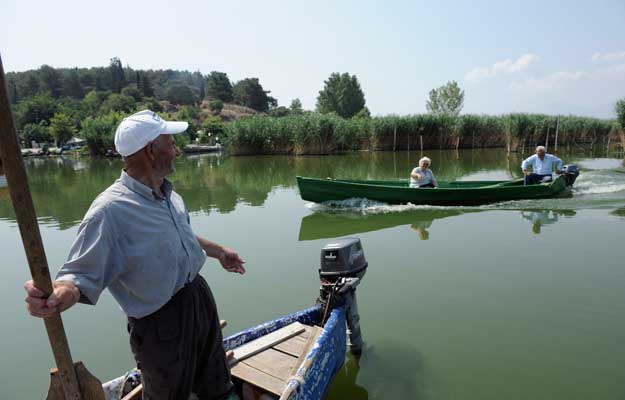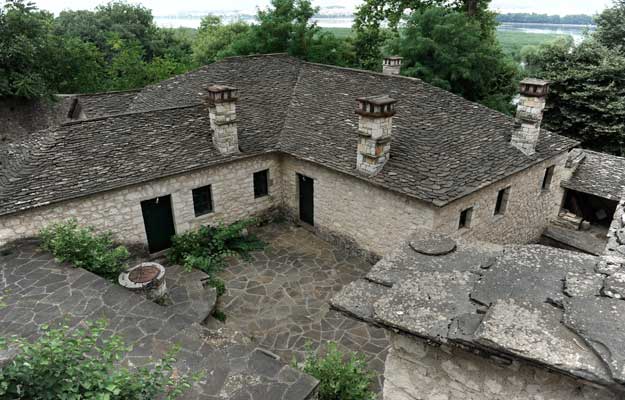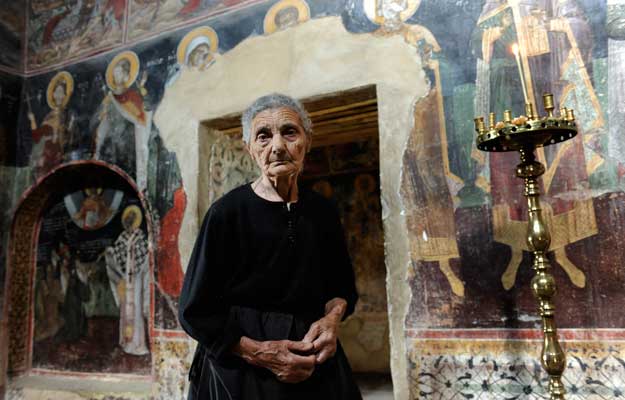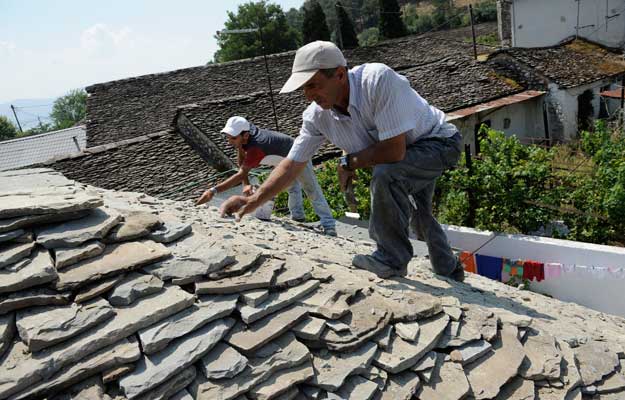Pictures: www.kathimerini.gr
This is one of the few inhabited lake islands in the world. It is associated with Pamvotida Lake and Ioannina and has remained unnamed – the microscopic "Island Lake" or "The Islet of Ioannina." It has an area of less than 200 acres, with a traditional Epirus stone settlement, built on rocks. It hosts 7 Byzantine and Post Byzantine monasteries which form a monastic community that is the third largest in Greece after the ones in Mount Athos and Meteora.
Back in time
The island is not isolated, especially during the summer, when boats arrive every half hour from Ioannina. The journey takes 10 minutes and looks like a mini trip back in time. The narrow streets of the island start from the pier, whitewashed like those on the Aegean Islands. The small courtyards of the houses that are made of stone are also white - wonderful examples of the architecture of Epirus. One and the same families have owned them for generations.

Tradition in hospitality
Todoros Gekas is one of the oldest inhabitants of the island, and probably holds the Greek record, since he has been elected mayor for six successive terms: from 1974 to 1998. He knows the history and traditions of the place in detail. "It is said that the first inhabitants of the area came from the Mani region in the Peloponnese: in those years prisoners of war or slaves who were brought to Ioannina by Arslan Pasha. Since these prisoners knew fishery and sailing, they initially settled in coastal areas adjacent to the island. In the late 18th century, they moved to the island. Since then, they dealt mainly with fishing and tourism," said Gekas.
Indeed, believers from the entire region come here for the festivals of the monasteries. During the Ottoman rule, inhabitants of multicultural Ioannina hired boats from the islanders, took food and their musical instruments with them and made night rows in the moonlight: Christians on Sundays, Jews on Saturdays and Muslims on Fridays, Gekas added.

However, fishing has always been the main occupation of the inhabitants. More than 10 species of freshwater fish live in the lake, besides eels and carp, imported from Italy in 1924 by a fishing cooperative - the first of its kind in Greece. Carp which had not been part of the diet of the inhabitants of Ioannina for many years saved them from starvation during the German occupation, when the islanders, at the request of the Bishop, fished for large quantities and handed them out to the population. Islanders have continuously enriched fish in the lake with new species, some of which have adapted, while others have not. Today, the largest quantities of fish are exported to Balkan countries, and mainly Romania.
The main income of the 250 inhabitants of the island, however, came from boats that are owned by 2 or 3 and sometimes even 4 families together. There are more than 20 shops and restaurants, most of which are owned by local residents, Aris Lyoubos, chairman of the local council explained. Although half of the residents are elderly, the population of the island is permanent. There has never been a secondary school here. In the past, 40 children studied at the elementary school, but today it does not exist either.
Connections to Ioannina

The stories of the elderly make it clear that the greatest difficulties in the life of the islanders have been the connections to Ioannina which are carried out only by boats. In the past, boats had a lot heavier oars than now, and when north winds blew, the journey became impossible because of high waves. Now, there is no need to row, since everybody has motor boats. No cars cn circulate on the island, since the streets are too narrow. It is not possible to build new houses, since there is not enough space.
Tourism in the crisis
The lack of land is one of the reasons why the island does not have guest houses. The crisis has also influenced the island. Based on boat tickets sales, the number of visitors has dropped by 40%. These are mostly Greek tourists. Recently, efforts of the Municipality of Ioannina have increased the number of Russian tourists mainly because of their interest in the monasteries, as well as the number of Turkish and Albanian tourists because of the history and the museum of Ali Pasha. The opening of the Egnatia road has made the whole area more accessible. In the crisis, everybody is returning again to fishing.
The environment

Pamvotida Lake is not as rich as in the past. The draining of its twin lake, Lapsista, in the mid-50s drastically reduced the water supply to Pamvotida. Eels have disappeared almost completely, since they no longer have an exit to the Kalama River and through it to the sea for their journey to the Sargasso Sea where they reproduce. For decades, pesticides and fertilizers which are used more and more extensively these days, sewers, and all types of farms, crafts and industrial activities have been negatively affecting this complex ecosystem, so that it has ultimately lost a significant part of its capacity for self-purification. "Basically, the biggest coastal area of the lake was surrounded by reeds, which filtered the pollution. But we cleansed the land, built night centres and eventually turned the lake into a "bathtub" where all our waste is stored and deposited," said Costas Gekas, councillor of Ioannina. The water treatment plant has partially solved the problem, but the problem with heavy metals in the water still remains.
The unification of monasteries

Today, in addition to the restoration of the environment, the unification of the monasteries in a fully accessible network is the most important issue to the residents of the island. Both Byzantine monasteries - Filantropinon and Stratigopoulou have tremendous historical and religious value. These monasteries are outstanding examples of Epirus art. Up to the mid-18th century, when Ioannina became a centre of the Greek Enlightenment, these monasteries were an important educational centre. The Metropolis of Ioannina has restored them and created a convention centre; and with the help of the municipality and the Ministry of Culture, it has turned the monastery of Eleusis into a modern museum. When the entire project is completed, the monasteries will become a centre of religious, historical and congress tourism.

Islanders respond differently when asked what makes them stay here - the beauty of nature, the continuation of the tradition or the sense of security. All answers are correct. However, Theodoros Gekas said "It is good luck to live in a beautiful place which others want to visit. And I love meeting them."